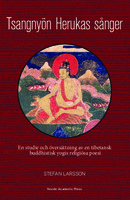Tsangnyön Herukas sånger
En studie och översättning av en tibetansk buddhistisk yogis religiösa poesi
| dc.contributor.author | Larsson, Stefan | |
| dc.date.accessioned | 2018-10-01 23:55:55 | |
| dc.date.accessioned | 2019-02-05 11:06:24 | |
| dc.date.accessioned | 2020-04-01T11:56:31Z | |
| dc.date.available | 2020-04-01T11:56:31Z | |
| dc.date.issued | 2018 | |
| dc.identifier | 1002464 | |
| dc.identifier | OCN: 1082944592 | en_US |
| dc.identifier.uri | http://library.oapen.org/handle/20.500.12657/27540 | |
| dc.description.abstract | "The core of the book is a complete annotated translation of the collected ‘religious poetry’ (Tibetan: mgur) of the Tibetan yogin Tsangnyön Heruka (gTsang smyon Heruka, 1452–1507). The book also contains a translation of a short ‘catalogue’ (dkar chag) of Tsangnyön’s poetry/songs. These two texts were compiled and printed in 1508 by a group of disciples who wanted to express their devotion to their recently deceased master, and make his insights available for others. The Songs of Tsangnyön Heruka begins with an extensive scholarly introduction to Tsangnyön and his songs, providing the reader with a context to the translations. Following the two translated texts, is an appendix introducing Tibetan Buddhism to the general reader, then comes a glossary explaining some of the key terms used in the songs, and finally some back matters, i.e. end notes and bibliographies. Nowadays, Tsangnyön Heruka is mainly known for having written and printed the ‘life story’ (rnam thar) and ‘song collection’ (mgur ’bum) of the famous poet-saint Milarepa (1040–1123). However, Tsangnyön is not only one of Tibet’s foremost authors and poets, he is also one of the best known ‘holy madmen’ (smyon pa) of Tibet. These colourful figures challenged powerful leaders and monks with their peculiar and seemingly crazy ways. In sharp contrast to Milarepa’s life story and songs, Tsangnyön’s were gradually forgotten. Tsangnyön’s songs provide us with a fascinating and direct insight into the lifestyle, teachings, and message of the wandering yogins. Moreover, they give us an idea of how it was in Tibet before the Fifth Dalai Lama came to power in the mid-17th century. However, the songs have a direct, down-to-earth, and human message, making them timeless and relevant also for people living in another time and culture. These songs have never been translated to any language, and they have never been studied thoroughly before." | |
| dc.language | Swedish | |
| dc.subject.classification | thema EDItEUR::D Biography, Literature and Literary studies::DC Poetry::DCF Poetry by individual poets | en_US |
| dc.subject.classification | thema EDItEUR::N History and Archaeology::NH History | en_US |
| dc.subject.classification | thema EDItEUR::N History and Archaeology::NH History::NHF Asian history | en_US |
| dc.subject.classification | thema EDItEUR::Q Philosophy and Religion::QR Religion and beliefs | en_US |
| dc.subject.classification | thema EDItEUR::Q Philosophy and Religion::QR Religion and beliefs::QRF Buddhism | en_US |
| dc.subject.classification | thema EDItEUR::Q Philosophy and Religion::QR Religion and beliefs::QRF Buddhism::QRFB Buddhism: branches and groups::QRFB2 Mahayana Buddhism::QRFB21 Tibetan Buddhism | en_US |
| dc.subject.other | Tsangnyön Heruka | |
| dc.subject.other | Kagyu | |
| dc.subject.other | Milarepa | |
| dc.subject.other | Tibetan Buddhism | |
| dc.subject.other | Religious poetry | |
| dc.subject.other | Nature of the mind | |
| dc.title | Tsangnyön Herukas sånger | |
| dc.title.alternative | En studie och översättning av en tibetansk buddhistisk yogis religiösa poesi | |
| dc.type | book | |
| oapen.identifier.doi | 10.21525/kriterium.10 | |
| oapen.relation.isPublishedBy | 7b034f4a-b816-4718-88ac-63b24c8e4b24 | |
| oapen.relation.isbn | 9789188661340 | |
| oapen.pages | 273 | |
| oapen.place.publication | Gothenburg | |
| oapen.identifier.ocn | 1082944592 |

